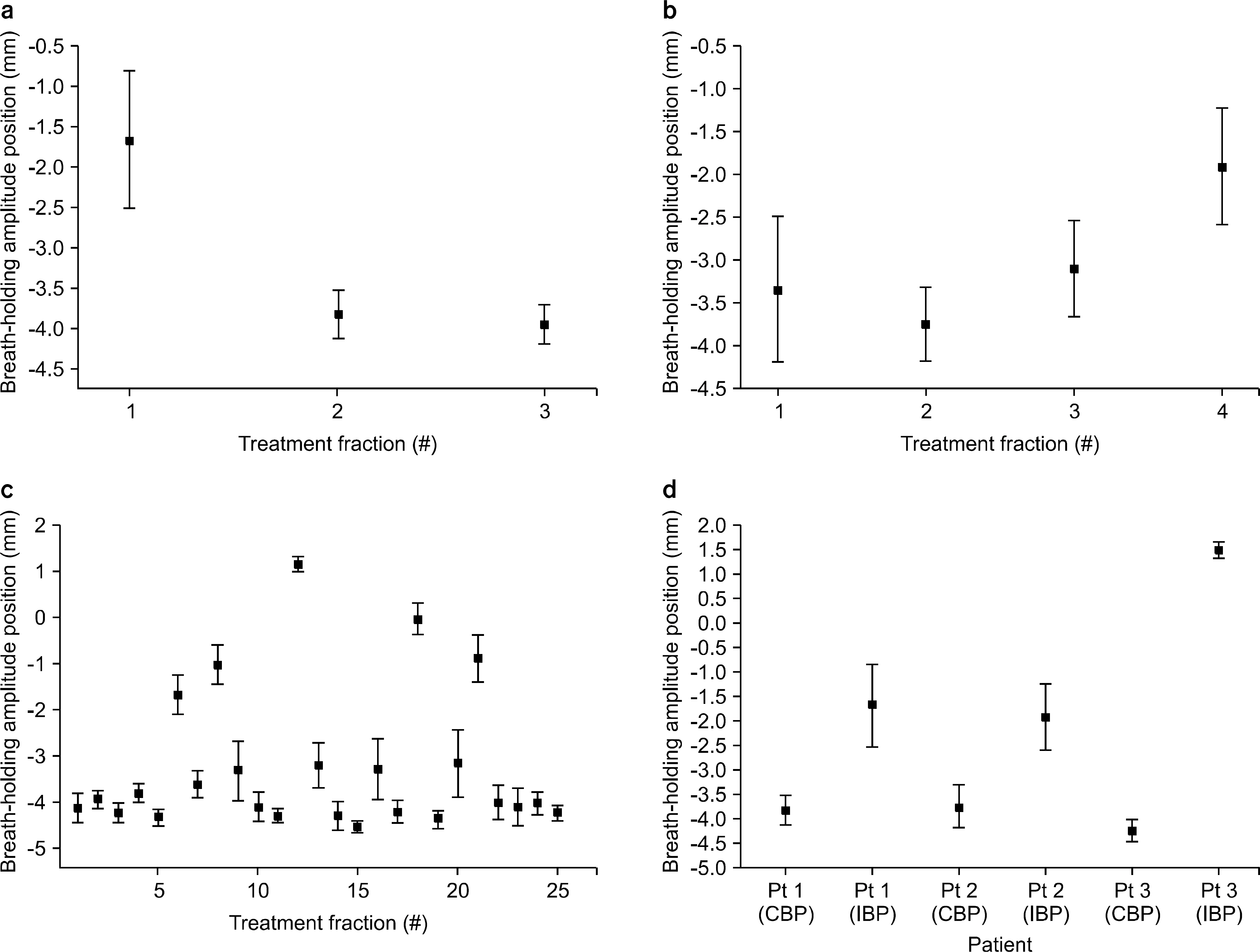Prog Med Phys.
2015 Sep;26(3):127-136. 10.14316/pmp.2015.26.3.127.
Dosimetric Evaluation of Amplitude-based Respiratory Gating for Delivery of Volumetric Modulated Arc Therapy
- Affiliations
-
- 1Department of Radiation Oncology, College of Medicine, Inha University, Incheon, Korea. hyundohuh@gmail.com
- 2Department of Radiation Oncology, College of Medicine, Soonchunhyang University, Cheonan, Korea.
- 3Department of Radiation Oncology, College of Medicine, KyungHee University, Seoul, Korea.
- 4Research Institute of Radiological and Medical Sciences, Korea Institute of Radiological and Medical Sciences, Seoul, Korea.
- KMID: 2069475
- DOI: http://doi.org/10.14316/pmp.2015.26.3.127
Abstract
- The purpose of this study is to perform a dosimetric evaluation of amplitude-based respiratory gating for the delivery of volumetric modulated arc therapy (VMAT). We selected two types of breathing patterns, subjectively among patients with respiratory-gated treatment log files. For patients that showed consistent breathing patterns (CBP) relative to the 4D CT respiration patterns, the variability of the breath-holding position during treatment was observed within the thresholds. However, patients with inconsistent breathing patterns (IBP) show differences relative to those with CBP. The relative isodose distribution was evaluated using an EBT3 film by comparing gated delivery to static delivery, and an absolute dose measurement was performed with a 0.6 cm3 Farmer-type ion chamber. The passing rate percentages under the 3%/3 mm gamma analysis for Patients 1, 2 and 3 were respectively 93.18%, 91.16%, and 95.46% for CBP, and 66.77%, 48.79%, and 40.36% for IBP. Under the more stringent criteria of 2%/2 mm, passing rates for Patients 1, 2 and 3 were respectively 73.05%, 67.14%, and 86.85% for CBP, and 46.53%, 32.73%, and 36.51% for IBP. The ion chamber measurements were within 3.5%, on average, of those calculated by the TPS and within 2.0%, on average, when compared to the static-point dose measurements for all cases of CBP. Inconsistent breathing patterns between 4D CT simulation and treatment may cause considerable dosimetric differences. Therefore, patient training is important to maintain consistent breathing amplitude during CT scan acquisition and treatment delivery.
Keyword
MeSH Terms
Figure
Reference
-
References
1. M Teoh, C H Clark, K Wood, et al. Volumetricmodulated arctherapy: areviewofcurrentliteratureandclinicalusein practice. Br J Radiol. 84:967–996. 2011.2. Li R, Mok E, Han B, et al. Evaluationofthegeometricaccu-racyofsurrogate-basedgatedVMATusingintrafractionkilovoltagex-rayimages. Med Phys. 39:2686–2693. 2012.3. Choi K, Xing L, Koong A, et al. Firststudyofon-treatment volumetricimagingduringrespiratorygatedVMAT.Medical physics.UnitedStates: AmericanAssociationofPhysicistsin Medicine.40 (. 2013.4. Jiwon Sung, Myonggeun Yoon, Weon Kuu Chung, et al. EvaluationoftheAccuracyforRespiratory-gatedRapidArc. PROGRESSinMEDICALPHYSICS.24, No.2 (. 2013.5. G. Nicolini, E. Vanetti, A. Clivio, et al: Preclinicalevaluationofrespiratory-gateddeliveryofvolumetricmodulatedarc therapywithRapidArc.Phys.Med.Biol. 55:347–357. 2010.6. J. Qian, L. Xing, W. Liu, et al: Doseverificationforrespiratorygatedvolumetricmodulatedarctherapy.Phys.Med.Biol. 56:4827–838. 2011.7. Craig Riley, Yong Yang, Tianfang Li, et al. Dosimetric evaluationoftheinterplayeffectinrespiratory-gatedRapidArc radiationtherapy. Med. Phys. 41:011715. 2014.8. Otto K. Volumetricmodulatedarctherapy: IMRTinasingle gantryarc. Med. Phys. 35(1):310–17. 2008.9. D. A. Low, W. B. Harms, S. Mutic, et al: Atechniquefor thequantitativeevaluationofdosedistributions.Med.Phys. 25:656–661. 1998.10. N. Agazaryan, T. D. Solberg, J. J. DeMarco: Patient specificqualityassuranceforthedeliveryofintensitymodulated radiotherapy.J.Appl.Clin.Med.Phys. 4:40–50. 2003.11. Valeria Casanova Borca, Massimo Pasquino, Giuliana Russo, et al. DosimetriccharacterizationanduseofGAFCH-ROMICEBT3filmforIMRTdoseverification.J.ofAppl.Clin. Med.Phys.14: No.2 (. 2013.12. Kan MWK, Cheung JYC, Leung LHT, et al. Theaccuracy ofdosecalculationsbyanisotropicanalyticalalgorithmsforster-eotacticradiotherapyinnasopharyngealcarcinoma.Phys.Med. Biol. 56:397. 2011.
- Full Text Links
- Actions
-
Cited
- CITED
-
- Close
- Share
- Similar articles
-
- Dosimetric Comparison of Noncoplanar and Coplanar Volumetric Modulated Arc Therapy Plans for Esophageal Cancer
- Segmental Analysis Trial of Volumetric Modulated Arc Therapy for Quality Assurance of Linear Accelerator
- Dosimetric comparison of volumetric modulated arc therapy with robotic stereotactic radiation therapy in hepatocellular carcinoma
- A Dosimetric Comparision of IMRT and VMAT in Synchronous Bilateral Breast Cancer
- Dosimetric Evaluation of Low-Dose Spillage Volumes for Head and Neck Cancer Using Intensity-Modulated Radiation Therapy and Volumetric Modulated Arc Therapy Treatment Techniques






